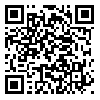Sun, Nov 30, 2025
[Archive]
Volume 14, Issue 44 (2022)
JMED 2022, 14(44): 19-27 |
Back to browse issues page
Download citation:
BibTeX | RIS | EndNote | Medlars | ProCite | Reference Manager | RefWorks
Send citation to:



BibTeX | RIS | EndNote | Medlars | ProCite | Reference Manager | RefWorks
Send citation to:
Araghian Mojarad F, Shirmohammadi Y, Talebian F, Malekzadeh R, Yaghoubi T. Evaluation of Challenges and Benefits of Preceptorship Model in Nursing Clinical Education: A Review Study. JMED 2022; 14 (44) :19-27
URL: http://edujournal.zums.ac.ir/article-1-1482-en.html
URL: http://edujournal.zums.ac.ir/article-1-1482-en.html
Fereshteh Araghian Mojarad1  , Yasman Shirmohammadi2
, Yasman Shirmohammadi2  , Fatemeh Talebian2
, Fatemeh Talebian2  , Roya Malekzadeh3
, Roya Malekzadeh3  , Tahereh Yaghoubi *4
, Tahereh Yaghoubi *4 
 , Yasman Shirmohammadi2
, Yasman Shirmohammadi2  , Fatemeh Talebian2
, Fatemeh Talebian2  , Roya Malekzadeh3
, Roya Malekzadeh3  , Tahereh Yaghoubi *4
, Tahereh Yaghoubi *4 
1- Research Center for Traditional and Complementary Medicine, Mazandaran University of Medical Sciences, Sari, Iran.
2- Student Research Committee, Mazandaran University of Medical Sciences, Sari, Iran
3- Vice Chancellor for Education, Mazandaran University of Medical Sciences, Sari, Iran
4- Research Center for Traditional and Complementary Medicine, Mazandaran University of Medical Sciences, Sari, Iran. ,tyaghubi@gmail.com
2- Student Research Committee, Mazandaran University of Medical Sciences, Sari, Iran
3- Vice Chancellor for Education, Mazandaran University of Medical Sciences, Sari, Iran
4- Research Center for Traditional and Complementary Medicine, Mazandaran University of Medical Sciences, Sari, Iran. ,
Abstract: (6552 Views)
Background & Objective: The preceptorship model is a training and learning approach, evaluation of benefits of challenges of which can contribute to the improvement of education quality and training of efficient nurses. The present study aimed to review the challenges and benefits of the preceptorship model in nursing clinical education.
Materials & Methods: This study was conducted as a narrative review. To select articles, Farsi databases such as Magiran, Google Scholar, SID, and Barakat Knowledge Network System using keywords of “preceptorship”, “nursing education”, “challenge”, “preceptor”, and “nursing student” were searched. In addition, databases of Google Scholar, Scopus, Science Direct, PubMed and Web of Science were investigated applying keywords of preceptorship, nursing education, nursing student, challenge and preceptors. Inclusion criteria were Farsi and English articles published up to 2020 with no time limits, access to full texts of the articles and relevance to the research objective. In the end, 10 out of 160 extracted articles were considered appropriate and entered into the study.
Results: In this study, the challenges of the preceptorship model were related to preceptors (high workload and insufficient time for education), preceptees (students’ lack of desire for direct care and lack of motivation) and the education atmosphere (insufficient support by school managers and poor correlation between theory and clinic). On the other hand, the benefits of the preceptorship model were related to students (reduced clinical errors and development of nursing skills) and education (ensuring compliance with the policies and procedures of the organization and targeted internships)
Conclusion: According to the results of the study, despite the numerous barriers to the implementation of the preceptorship model, it has many benefits. Therefore, our findings could help clinical instructors and nursing education authorities eliminate the challenges of the implementation of the model, which increases the quality of students’ clinical education.
Materials & Methods: This study was conducted as a narrative review. To select articles, Farsi databases such as Magiran, Google Scholar, SID, and Barakat Knowledge Network System using keywords of “preceptorship”, “nursing education”, “challenge”, “preceptor”, and “nursing student” were searched. In addition, databases of Google Scholar, Scopus, Science Direct, PubMed and Web of Science were investigated applying keywords of preceptorship, nursing education, nursing student, challenge and preceptors. Inclusion criteria were Farsi and English articles published up to 2020 with no time limits, access to full texts of the articles and relevance to the research objective. In the end, 10 out of 160 extracted articles were considered appropriate and entered into the study.
Results: In this study, the challenges of the preceptorship model were related to preceptors (high workload and insufficient time for education), preceptees (students’ lack of desire for direct care and lack of motivation) and the education atmosphere (insufficient support by school managers and poor correlation between theory and clinic). On the other hand, the benefits of the preceptorship model were related to students (reduced clinical errors and development of nursing skills) and education (ensuring compliance with the policies and procedures of the organization and targeted internships)
Conclusion: According to the results of the study, despite the numerous barriers to the implementation of the preceptorship model, it has many benefits. Therefore, our findings could help clinical instructors and nursing education authorities eliminate the challenges of the implementation of the model, which increases the quality of students’ clinical education.
Article Type : Review |
Received: 2021/08/10 | Accepted: 2021/12/26 | Published: 2022/02/19
Received: 2021/08/10 | Accepted: 2021/12/26 | Published: 2022/02/19
Send email to the article author
| Rights and permissions | |
 |
This work is licensed under a Creative Commons Attribution-NonCommercial 4.0 International License. |


